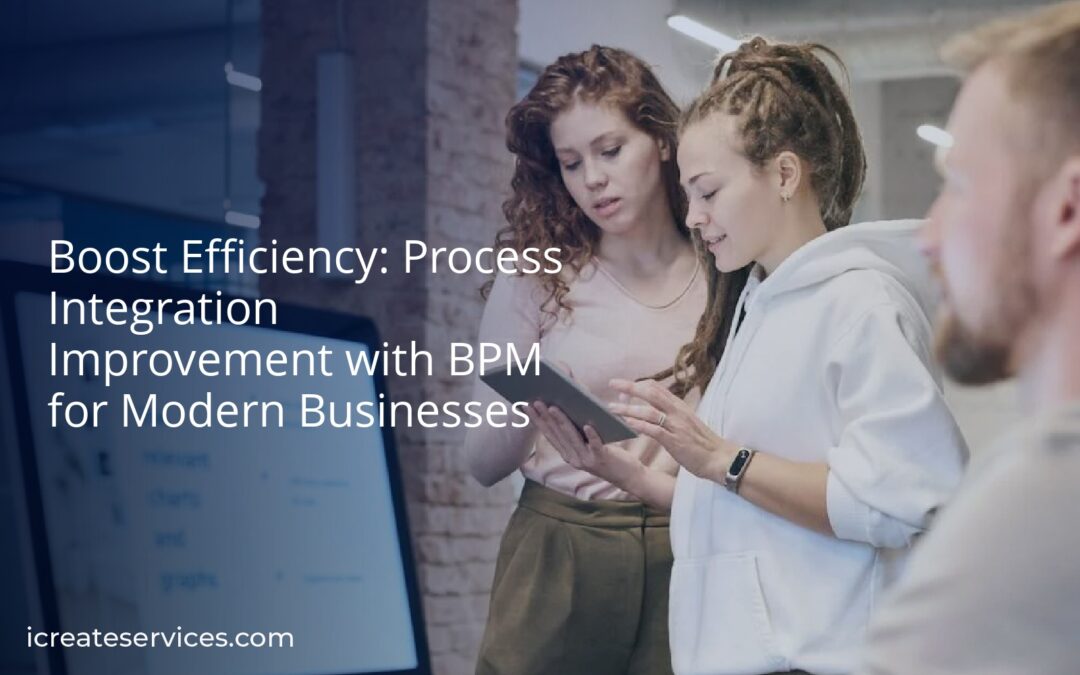What Is BPM?
Business Process Management (BPM) optimizes and manages an organization’s processes. It’s a structured approach that involves analyzing, designing, implementing, monitoring, and improving business activities. The primary goal is to enhance efficiency, effectiveness, and adaptability.
Analyzing: Involves understanding current processes to identify areas for improvement. This includes mapping workflows and pinpointing bottlenecks.
Designing: Focuses on creating streamlined processes. We design processes considering best practices and technological capabilities.
Implementing: Entails putting designed processes into action. We usually utilize technological tools, such as BPM software, to achieve this.
Monitoring: This phase ensures that processes perform as intended. We track key performance indicators (KPIs) to measure effectiveness.
Improving: Continuously refining processes based on feedback, KPIs, and emerging business needs ensures optimal performance and adaptability.
BPM isn’t a one-time task; it’s a continuous cycle. This repetitive nature ensures that processes evolve with the organization’s needs, technology advancements, and market changes.
Benefits of Process Integration Improvement with BPM
Process integration improvement with BPM brings several benefits to an organization by enhancing operations and adding value.
Enhanced Efficiency
Integrating processes with BPM significantly boosts efficiency. We streamline workflows, eliminating bottlenecks and reducing manual intervention. BPM tools automate repetitive tasks, ensuring consistency and accuracy. By aligning processes with organizational goals, we enhance productivity and responsiveness.
Cost Reduction
Process integration with BPM leads to notable cost reductions. Automation replaces manual processes, cutting labor costs. By identifying and eliminating redundancies, we minimize operational expenses. BPM also optimizes resource allocation, making better use of available assets and reducing waste.
Improved Compliance
BPM enhances compliance by ensuring that all processes adhere to regulatory standards. Through automated monitoring and reporting, we maintain accurate records and facilitate audits. BPM solutions offer real-time insights, enabling prompt adjustments to meet compliance requirements, reducing the risk of regulatory penalties.
Overall, BPM ensures that our processes evolve with changing needs, making our operations more efficient, cost-effective, and compliant.
Key Components of BPM for Process Integration
We need several key components to achieve process integration with Business Process Management (BPM). These components ensure streamlined workflows, effective automation, and continuous performance monitoring.
Process Modeling
Process modeling involves visual representation of business processes. It helps us identify inefficiencies and streamline operations. By creating models, we can map out existing workflows and plan improvements. These models serve as a guide for implementation and monitoring.
Workflow Automation
Workflow automation replaces manual tasks with automated actions. We configure rules and design workflows to manage routine processes. This reduces errors and speeds up operations. Automated workflows lead to consistent outcomes and free up resources for higher-value tasks.
Performance Monitoring
Performance monitoring involves continuous tracking of processes. We use metrics and key performance indicators (KPIs) to assess efficiency and effectiveness. This data allows us to make informed decisions and drive improvements. Monitoring ensures processes remain aligned with business goals and adapt to changes.
Best Practices for Implementing BPM
Implementing BPM strategically improves process efficiency and effectiveness. Following best practices ensures successful BPM integration.
Define Clear Objectives
Set specific objectives for BPM initiatives. Ensure these goals align with business priorities. For example, aim to reduce processing times by 20% or cut costs by 15% within six months. Document these objectives to provide clear direction.
Involve Stakeholders
Engage all relevant stakeholders from the start. Include management, IT, and end-users in discussions. For example, gather input from department heads and frontline employees on pain points and improvement areas. Their insights ensure the BPM system meets actual needs and gains broader support.
Monitor and Optimize Continuously
Monitor BPM performance using key metrics and KPIs. Track process cycle times, error rates, and resource utilization. For instance, if error rates increase, identify the root cause and adjust processes accordingly. Continuously refine workflows to maintain alignment with evolving business goals and market conditions.
Case Studies
Successful BPM implementations reveal valuable insights into enhancing process integration. These studies demonstrate practical applications and highlight the resulting business transformations.
Successful Implementations
- Company A: A global manufacturing firm streamlined its supply chain, integrating diverse systems for improved data flow. This helped reduce delivery times by 25%, minimizing costs and increasing customer satisfaction.
- Company B: A healthcare provider improved patient data management, integrating electronic health records. This enabled faster retrieval of patient information, enhancing care quality and operational efficiency.
- Company C: A financial services company automated compliance workflows, reducing manual processing errors. Automated processes led to a 30% improvement in compliance accuracy, meeting regulatory standards more effectively.
- Stakeholder Engagement: Effective process integration requires active stakeholder involvement. Their insights into day-to-day operations enable more accurate process mapping.
- Clear Objectives: Defining specific goals clarifies the direction of BPM initiatives. Clear objectives align the project with overall business strategies.
- Technology Alignment: Integrating the right technology stack ensures seamless system communication. Compatibility between existing and new tools facilitates smoother transitions.
- Continuous Monitoring: Ongoing performance tracking identifies areas for improvement. Adapting processes based on real-time data ensures sustained efficiency and effectiveness.
These case studies illustrate the tangible benefits BPM brings to diverse industries, emphasizing the importance of strategic implementation and continuous optimization.
Conclusion
BPM offers a robust framework for enhancing process integration in any organization. By leveraging BPM’s capabilities, we can achieve significant improvements in efficiency, cost savings, and compliance. The case studies we’ve explored highlight the transformative potential of BPM across various industries. Engaging stakeholders, setting clear objectives, aligning technology, and maintaining continuous monitoring are critical for successful BPM implementation. With strategic deployment and ongoing optimization, BPM can drive substantial benefits, making it an essential tool for modern businesses.
- Demystifying Fuel Test Procedures and Standards - January 16, 2025
- The Benefits of SAP Invoice Management in Financial Processes - December 4, 2024
- Enterprise Software for Comprehensive Risk Management - July 29, 2024




